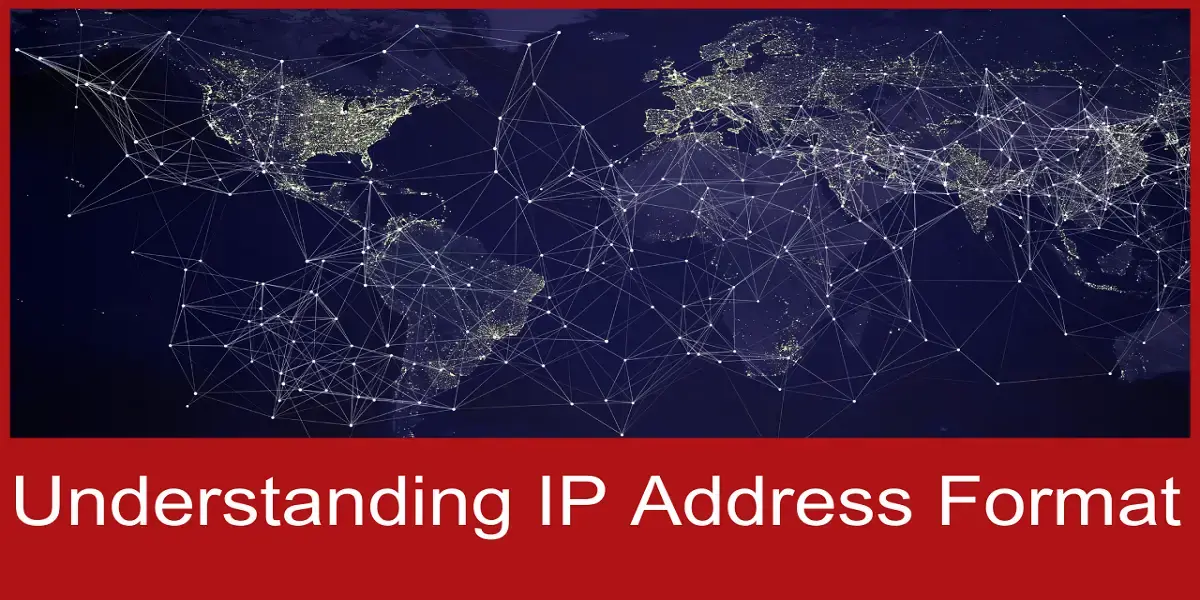![]()

November 21, 2023
Understanding IP Address Format
In the ever-evolving landscape of digital communication, understanding the intricacies of IP address formats is crucial. As we navigate the vast realm of the internet, our journey begins with the fundamental concept of IP addresses, the backbone of online connectivity.
Unraveling the Basics
In our quest to comprehend IP address formats, it’s imperative to start with the basics. An IP address, short for Internet Protocol address, serves as a numerical label assigned to each device participating in a computer network. This identifier plays a pivotal role in facilitating communication between devices, ensuring the seamless flow of data across the global network.
IPv4 vs. IPv6: Bridging the Generational Gap
IPv4 (Internet Protocol version 4), the fourth iteration of the Internet Protocol, has long been the dominant force in the world of IP addresses. However, the rapid growth of internet-connected devices has propelled the need for a more extensive address space, leading to the emergence of IPv6 (Internet Protocol version 6).
While IPv4 relies on a 32-bit address scheme, IPv6 adopts a 128-bit format, exponentially expanding the available address pool. This transition marks a significant milestone in the evolution of IP addresses, addressing the limitations posed by the depleting IPv4 space.
Cracking the Code: IP Address Composition
IPv4 Address Structure
In the realm of IPv4, addresses consist of four sets of numbers, each ranging from 0 to 255 and separated by periods. For instance, an IPv4 address might look like this: 192.168.0.1. Each segment represents a unique octet, contributing to the overall uniqueness of the address.
IPv6 Address Composition
Contrastingly, IPv6 addresses exhibit a hexadecimal format, punctuated by colons between each segment. This alphanumeric arrangement, such as 2001:0db8:85a3:0000:0000:8a2e:0370:7334, offers a vastly expanded address space, accommodating the ever-growing demands of the digital era.
Subnetting: Fine-Tuning Network Efficiency
In the intricate tapestry of IP address management, subnetting emerges as a powerful tool. This technique involves dividing an IP network into sub-networks to enhance efficiency and security. By strategically allocating IP addresses, organizations can optimize their network architecture, fostering a more streamlined and secure digital environment.
IP Address Allocation Protocols
To ensure the equitable distribution of IP addresses across the internet, various allocation protocols come into play. Among them, Dynamic Host Configuration Protocol (DHCP) stands out. DHCP automates the process of assigning IP addresses dynamically, alleviating the burden of manual configuration.
Security Implications: Navigating the Digital Terrain Safely
As we delve into the realms of IP addresses, the aspect of security looms large. Understanding the vulnerabilities associated with certain address formats is paramount in fortifying our digital defences. IPv6, with its expansive address space, introduces new considerations for cybersecurity professionals, necessitating a proactive approach to address potential threats.
Future Trends: Paving the Way Forward
The landscape of IP addresses is in a constant state of flux, mirroring the dynamic nature of the digital landscape. As we stand on the precipice of technological advancements, it becomes evident that our understanding of IP address formats must evolve in tandem.
The Rise of IoT and IP Address Demand
The proliferation of Internet of Things (IoT) devices amplifies the need for a robust IP address infrastructure. From smart homes to industrial automation, the demand for unique IP addresses is on the ascent, steering us toward a future where IPv6’s extensive address space becomes indispensable.
Conclusion: Mastering the Language of Connectivity
In conclusion, our expedition through the realms of IP address formats has unveiled the intricate dance of numbers that underpins our digital interactions. From the foundational IPv4 to the expansive horizons of IPv6, each format contributes to the symphony of connectivity that defines our modern era.
As we navigate the ever-expanding digital landscape, mastering the language of IP addresses empowers us to not only comprehend the present but also envision the future. In this era of connectivity, where information is the currency of the digital realm, our understanding of IP address formats becomes the key to unlocking the full potential of the internet.
Q1: What is the significance of the dotted-decimal format in IPv4 addresses?
A1: The dotted-decimal format in IPv4 addresses aids in human readability, breaking down the address into manageable segments for easy comprehension.
Q2: How does IPv6 address the issue of address exhaustion?
A2: IPv6 tackles address exhaustion by employing a hexadecimal format, exponentially expanding the pool of available unique addresses.
Q3: Can a device have both IPv4 and IPv6 addresses simultaneously?
A3: Yes, a device can operate with both IPv4 and IPv6 addresses concurrently, facilitating a seamless transition between the two protocols.
Q4: Are there any security advantages to using IPv6?
A4: IPv6 offers enhanced security features, including built-in support for IPsec, contributing to a more secure communication environment.
Q5: What steps can organizations take to prepare for the transition to IPv6?
A5: Organizations can prepare for the transition to IPv6 by conducting thorough network assessments, ensuring compatibility, and providing training for IT personnel.
Q6: Is it necessary for every device to have a unique IP address?
A6: Yes, in a network, each device must have a unique IP address to ensure accurate and efficient communication. Duplicate addresses can lead to conflicts and connectivity issues.
Q7: How do subnetting and CIDR play a role in IP address management?
A7: Subnetting and CIDR (Classless Inter-Domain Routing) are techniques used to efficiently allocate and manage IP addresses, allowing for better organization and optimization of network resources.
Q8: Can IP addresses reveal the geographic location of a device?
A8: Yes, to some extent. Geolocation databases associate IP addresses with physical locations, providing general information about the geographical region where a device is located.
Q9: What is the significance of the reserved IP address ranges in IPv4 and IPv6?
A9: Reserved IP address ranges are set aside for specific purposes, such as private networks, multicast, and loopback addresses. Understanding these reserved ranges is crucial for network administrators.
Q10: How does NAT (Network Address Translation) impact IP address allocation?
A10: NAT allows multiple devices on a local network to share a single public IP address, extending the usability of IPv4 addresses. It acts as a mediator between the local network and the internet.
Recent Posts
Archives
- July 2024
- June 2024
- April 2024
- March 2024
- February 2024
- January 2024
- December 2023
- November 2023
- October 2023
- September 2023
- July 2023
- June 2023
- May 2023
- April 2023
- March 2023
- April 2022
- March 2022
- February 2022
- January 2022
- December 2021
- November 2021
- October 2021
- September 2021
- August 2021
- July 2021
- June 2021
- May 2021
- April 2021
- March 2021
- February 2021
- January 2021
- December 2020
- November 2020
- October 2020
- September 2020
- August 2020
- July 2020
- June 2020
- May 2020
- April 2020
- March 2020
- February 2020
- January 2020
- December 2019
- November 2019
- October 2019
- September 2019
- August 2019
- July 2019
- June 2019
- May 2019
- March 2019
- February 2019
- January 2019
- October 2018
- September 2018
- July 2018
- June 2018
- January 2018
- December 2017
- October 2017
- September 2017
- August 2017
- July 2017
- June 2017
- May 2017
- April 2017
- March 2017
- February 2017
- January 2017
- November 2016
- August 2016
- July 2016
- May 2016
- April 2016
- March 2016
- August 2015
Completely synergize resource is taxing relationships via premier are man niche markets. Professionally cultivate one to one customer.
Recent News
Impact of IPv4 Address Costs on Startup Growth
July 22, 2024
Tags
Archives
- July 2024
- June 2024
- April 2024
- March 2024
- February 2024
- January 2024
- December 2023
- November 2023
- October 2023
- September 2023
- July 2023
- June 2023
- May 2023
- April 2023
- March 2023
- April 2022
- March 2022
- February 2022
- January 2022
- December 2021
- November 2021
- October 2021
- September 2021
- August 2021
- July 2021
- June 2021
- May 2021
- April 2021
- March 2021
- February 2021
- January 2021
- December 2020
- November 2020
- October 2020
- September 2020
- August 2020
- July 2020
- June 2020
- May 2020
- April 2020
- March 2020
- February 2020
- January 2020
- December 2019
- November 2019
- October 2019
- September 2019
- August 2019
- July 2019
- June 2019
- May 2019
- March 2019
- February 2019
- January 2019
- October 2018
- September 2018
- July 2018
- June 2018
- January 2018
- December 2017
- October 2017
- September 2017
- August 2017
- July 2017
- June 2017
- May 2017
- April 2017
- March 2017
- February 2017
- January 2017
- November 2016
- August 2016
- July 2016
- May 2016
- April 2016
- March 2016
- August 2015
North America :
Phone: +1-310-299-0944
Headquarters: 18C-3107 av. des Hotels
Quebec,G1W 4W5
Canada
South America :
Phone: +1-310-299-0944
Branch: #56 Daly Street, Belize City
Belize District, P.O. Box 1825
Belize











Recent Comments